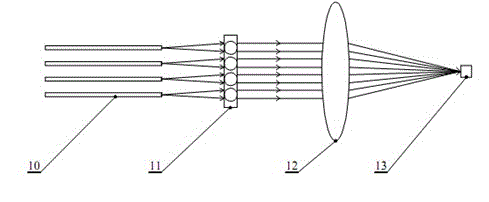Mode coupling light assembly
A mode coupling and optical component technology, applied in the field of optical communication, can solve the problems of optical fiber link optical power loss, optical signal weakening, and limitation, and achieve the effect of improving optical power budget, increasing transmission distance, and avoiding additional loss
- Summary
- Abstract
- Description
- Claims
- Application Information
AI Technical Summary
Problems solved by technology
Method used
Image
Examples
Embodiment Construction
[0021] In order to make the object, technical solution and advantages of the present invention clearer, the present invention will be further described in detail below in conjunction with the accompanying drawings and embodiments. It should be understood that the specific embodiments described here are only used to explain the present invention, not to limit the present invention.
[0022] figure 2 The optical path principle of the mode-coupling optical component provided by the first embodiment of the present invention is shown, and the mode-coupling optical component includes a collimator array 11 , an aspheric lens 12 and a photodetector 13 . The collimator array 11 collimates the optical signals emitted from each optical fiber 10 into parallel light, and the aspheric lens 12 converges the collimated parallel light onto the photodetector 13 .
[0023] In this embodiment, the optical coupler and the light receiving component are packaged together. The specific implementat...
PUM
 Login to View More
Login to View More Abstract
Description
Claims
Application Information
 Login to View More
Login to View More - Generate Ideas
- Intellectual Property
- Life Sciences
- Materials
- Tech Scout
- Unparalleled Data Quality
- Higher Quality Content
- 60% Fewer Hallucinations
Browse by: Latest US Patents, China's latest patents, Technical Efficacy Thesaurus, Application Domain, Technology Topic, Popular Technical Reports.
© 2025 PatSnap. All rights reserved.Legal|Privacy policy|Modern Slavery Act Transparency Statement|Sitemap|About US| Contact US: help@patsnap.com



